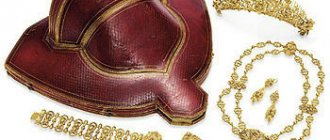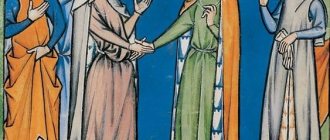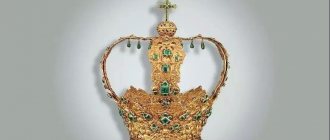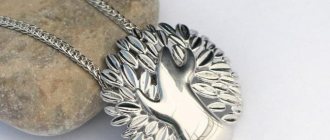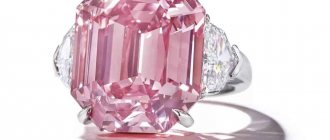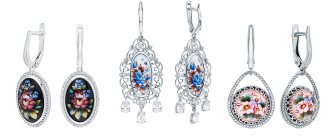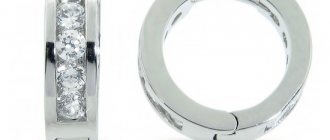A little earlier, we published the first article in a series of articles about artistic styles and jewelry - about historical styles (Baroque, Rococo, Classicism and Empire). Historically, the coming age of romanticism was preceded by the era of classicism (with its crowning Empire style) - a strict and balanced bourgeois style. However, which was destined to be replaced by its almost complete opposite.
The article mentioned above also provides a Western classification of jewelry styles. In accordance with it,
The styles and movements of the Romantic fit into the long years of Queen Victoria's reign - the famous and great "Victorian era" .
Classicism
Period: late 18th - early 19th century
Character traits:
- plots of ancient Greek and Roman mythology
- images of typical revolutionary motifs in the form of guillotines and portraits of revolutionary heroes
- repetition of architectural decorative elements, columns, vases, urns, ribbon bows
- symmetry, ovals, polygons in the form of elongated 8-sided cartouches, shields and rhomboids.
- techniques: mosaic, inlay of hair, paper, papier-mâché, ivory (with miniature paintings), verre églomisé and blue glass.
- stones: aquamarine, amethyst, chalcedony, turquoise, coral, amber, lapis lazuli and garnets.
- an alloy of 18 carat gold is replaced by an alloy of 14 and 8 carats
The French Revolution influenced society and its mood. People are inspired by the ideas of antiquity and this is reflected in fashion.
Layered outfits and powdered wigs replaced light clothing. Women's dresses were made from thin light fabrics and resembled ancient Greek tunics. The hair was tied at the back of the head, leaving the ears and deep necklines free.
What happened to the luxurious Baroque and Rococo decorations? They were remade, melted down and sold. These were difficult times of political change and revolution that required resources. Excessive behavior was frowned upon.
At first, jewelry was kept to a minimum or not worn at all. New products appear in the wardrobe gradually. Jewelers also gravitated towards the antique style, but in the mid-18th century they still had little understanding of how to show it in jewelry. Therefore, the main motives were taken from architecture.
With the beginning of Napoleon's reign, jewelry was worn more and more often. And yet “noble simplicity” remained in fashion.
Open ears and necklines called for long earrings, and the neckline was suitable for necklaces worn close to the neck. They also wore long chains on their shoulders - just like in the Renaissance. But unlike the Renaissance, neoclassical fashion is designed for everyone. Strict rules about who could wear what are disappearing. The difference between classes in fashion is erased. The general mood was influenced by the slogan “Freedom, equality, brotherhood.”
The conquest of Italy in 1796 and the Egyptian campaign brought new features to art: micromosaic techniques, carving of cameos, pyramids, sphinxes, scarabs, etc.
The demand for jewelry after 1800 changed the way the jewelry business was conducted. The industrial revolution also contributed to this. Instead of creating things in their own workshops, they were ordered from manufacturing companies. For example, in the city of Hanau in Germany.
Hanau was a "free city" where guild rules did not apply. From there, jewelry was exported to several European countries, did not obey the rules of branding - and even stamped with pseudo-brands on objects. Because of this, it is almost impossible to determine the origin of these jewelry.
Outside France, things looked a little simpler. Defeat in the war and occupation forced compensation to be paid and this hit the economy. Paris remained the capital of fashion, and other countries took inspiration from the fashions of previous years.
The return to ancient motifs was not to the liking of traditionalists. They continued to wear dresses from the early 18th century, and cartoonists ridiculed these habits. Conservatism was falling out of fashion. It was difficult for the nobles to come to terms with the new reality - these people did not identify themselves with the idea of equality for all.
Characteristic decorations for classicism:
During Napoleon's time, cameos became popular. They were primarily made from agate, but in the early 19th century people began carving them onto shells, which were cheap and easy to work with. Cameos were also made from other materials - glass, porcelain and even plaster.
The short sleeves of the dress became a reason to wear armlets and bracelets like Amazons
. This is especially evident after the Directory at the end of the 18th century.
The genre of memorial and mourning jewelry is spreading: miniatures made of papier-mâché, hair, ivory, eglomise, and blue glass. They were installed under glass or crystal covering.
Only black materials were used for mourning decorations. A special place among them belongs to cast iron (Berlin steel).
The shine of newness
The term “Victorian silver” does not necessarily imply that the authors belong to a circle of select jewelers or the large-scale size of the products. The so-called “Novelty silver” was intended for a wide range of collectors who were looking for rare items with an original design:
- toiletries;
- playing card cases:
- snuff boxes;
- bottles for smelling salts;
- salt and pepper shakers;
- caddy spoons for pouring tea leaves.
Craftsmen capitalized on the middle-class desire to show off to their neighbors by creating new functional or simply fun objects. Sampson Mordan and Nathaniel Mills were the most successful in this.
Silver ringing - literally - calmed babies: it was good form to give a rattle with bells made of noble metal for baptism.
Most of the objects are out of use these days; the purpose of some of them can be guessed for a long time by a modern person. But the skill of the work and the subtle sense of humor of the creators have not lost their value. Buying an antique silver item means making a good investment. At Very Important Lot you will find everything: from ceremonial sets to exquisite figurines.
Georgian period
Period: 1714-1837
Character traits:
- motifs: feathers, crowns, leaves, flowers; cornucopia, cross, bow, crescent, ribbons
- stones: garnet, topaz, emerald, ruby, turquoise, translucent agates, carnelian; coral, amber, ivory, pearl
- pinchbeck and tombac jewelry
- techniques: enameling, portrait miniatures, stamping, gimp
- to enhance the shine of diamonds, the backs of the jewelry were closed
- paste rhinestones, opal glass, artificial pearls, porcelain, beads
- 18k gold
- pear cut
Gimp
Twisted spiral thread made of gold or silver. Used since the beginning of the 19th century in jewelry, embroidery, and decoration.
The Georgian period begins with the reign of England's King George I in 1714 and ends with the arrival of Queen Victoria. And although the historical framework is clearly outlined by the reign of the Georges, the Georgian style itself was adjacent to the style of Louis XV and the Empire style.
The “Liberty, Equality, Fraternity” of the French Republic did not immediately appeal to the British. Until the mid-18th century, the nobility tried to conquer class boundaries. The laws specifically stated what clothes and jewelry were allowed to be worn according to status and income.
After these restrictions were lifted, there was a huge demand for jewelry. The range has become wider to meet the needs of people of different incomes. So much jewelry was created at this time that it remains available to this day.
The occasion and time of day determined the nature of the decorations. During the daytime, women wore a necklace or chain with a watch, a cameo or lace pin, rings, paired bracelets and earrings. An important element of daytime decorations was the chatelaine.
Gentlemen did not appear in society without exquisite buckles, buttons, and watch chains. Their jewelry was not inferior to women's and was decorated with precious stones, enamel, and rhinestones.
Characteristic decorations for the Georgian period:
Parures are sets of jewelry in the same style. Often included up to sixteen items. Parures with stones, diamonds or pearls were a mandatory part of a wealthy woman's wardrobe.
Transformable brooches are created with removable pendants and loops that turn them into necklaces.
Luxurious hairstyles were emphasized with appropriate decorations: tiaras, aigrettes, wreaths, hairpins, combs.
Popular neck jewelry: chokers, short riviera necklaces - necklaces made of homogeneous or identical stones without long links for fastening.
Chatelaines are in fashion - functional jewelry in the form of chains with clips, pins or hooks. The necessary household items are attached to them: watches, writing instruments, scissors, glasses, etc. The accessory itself was fixed on the belt.
This accessory is considered the predecessor of wallets and pockets, and was popular mainly among middle-class women.
Men also wore chatelaines, but limited themselves to keys and watches.
It is worth noting that chatelaines are not a Georgian invention. They have been known since the Middle Ages and Baroque eras. But they became widespread and functionally used in the 19th century. You can read about them in a separate article.
The decorations did not change from “Georgian” to “Victorian” as a result of the coronation of the new monarch. Elements and themes of Georgian decoration continue to be used and some evolve. This happened with memorial and mourning jewelry. They are considered a strong feature of the Victorian period, although they were created and worn in the 18th century.
The art of jewelers of ancient Rus'
At the end of the 15th and beginning of the 16th century, a most important period began for Russia. The time of the Mongol-Tatar yoke ended and a centralized state was formed. Moscow has become the center of the country's political, economic and cultural life. Court ceremonies required magnificent decoration, which became an incentive for the rapid development of jewelry. Artists, carvers, gunsmiths, embroiderers and foundry workers came to the capital from all over the Russian land. In addition to Russian craftsmen, foreign artisans of various specialties also worked. Under Ivan IV the Terrible there were especially many of them, and the German Settlement was formed. The collaboration of Russian and Western European craftsmen had a huge impact on the jewelry art of Russia at that time. At the same time, the creativity of Moscow jewelers retained its national character.
The work of Russian jewelers could be seen during special embassy ceremonies, which were established by Ivan the Terrible and lasted until the end of the 17th century with only a few changes.
Foreigners who visited Russia left rave reviews in their notes about the work of Moscow jewelers. The luxury of the attributes of royal power - a golden scepter strewn with precious stones, the richest porphyry, a golden diadem and the throne of the Russian Tsar - brought foreigners into indescribable delight. And the gold clothes of the servants, which they changed three times during dinner, aroused amazement and envy. In general, the royal court, even under subsequent kings, was distinguished by pomp and luxury. In Russian history, periods of rise alternated with decline. An example of this is the Polish-Swedish intervention of the early 17th century, during which the Kremlin storage facilities were pretty much emptied. At the end of 1612, when the enemies were driven out, a gradual revival began.
